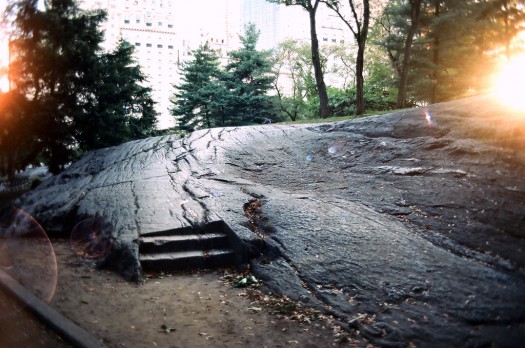
We are celebrating 15 years — and counting — of stories that are deeply researched and deeply felt, that build a historical record of what the city has been.
We are celebrating 15 years — and counting — of stories that are deeply researched and deeply felt, that build a historical record of what the city has been.
To mark the fifth anniversary of the launch of Urban Omnibus, we look at themes that have emerged in our content over time and think about what those threads reveal about the needs, desires, and priorities of the city today.
If there were a single quality that all Omnibus contributors and dedicated readers share, it might be described as a compulsion for looking deeply at their city. By looking deeply, I mean prolonged, analytical, and thoughtful observation that pushes into the uncelebrated recesses of urban life, often obscured from view or hidden in plain sight.

Manhattan Schist rock stairs (450 million years old), designed by Olmsted and Vaux in Central Park, as photographed by Robert Smithson in 1972.
In addition to the many artists who take the urban landscape as muse or canvas, we’ve published observations that investigate the enormity of New York through its largest, oldest, or most ubiquitous attributes. Elizabeth Ellsworth and Jamie Kruse research, explore, and document the form of our built environment, revealing vast and ancient geologic forces embedded in everything from the Triassic sandstone in Park Slope to geologic strata of our landfills. Indefatigably traversing the borough of Brooklyn, Neil Freeman has generated seemingly endless new ways of exploring the dizzying diversity of its neighborhoods and their housing types by layering different kinds of visual, textual, and visual data atop one another — his undertaking is called the Brooklyn Typology Project.
Streets are another common viewfinder for our urban explorers. Architectural historian Gabrielle Esperdy took us from the Manhattan Bridge to Jamaica Bay along Flatbush Avenue — one of the oldest and longest roads in Brooklyn — disclosing the influence of the Revolutionary War, Beaux Arts planning, and, naturally, Robert Moses. On a shorter trip, James Reeves walked the industrialized waterfront (or as close as he could get) from DUMBO to Greenpoint, noticing the “scotch tape and wires” that hold it, and the city, together.
Details too small or too common (or both) to otherwise garner careful observation are beloved to the Omnibus reader, and these particulars of urban life supply a great many opportunities to look and learn. Alison Carafa gave us a fresh and cheerful journey through New York City’s air conditioning units, including some of their unintended uses, hacks, and consequences. Kirsten Hively’s passion for the city’s neon signage has produced a loving document of what could be a fading feature of New York City nights. Linda Pollak’s obsessive, insightful observation and categorization of the granite carvings underfoot in Lower Manhattan is a form of urban archaeology that tells us much about eras of construction and settlement, the movement of water and pedestrians. David Seiter also encouraged us to look down — in an effort to communicate the value of “spontaneous urban plants,” Seiter literally highlights and carefully draws the underappreciated and tenacious plant life growing between cracks of pavement, and within vacant lots, rubble dumps and highway medians.
So when you are out in our great city, make sure to look around, and don’t forget to report back.
The views expressed here are those of the authors only and do not reflect the position of The Architectural League of New York.